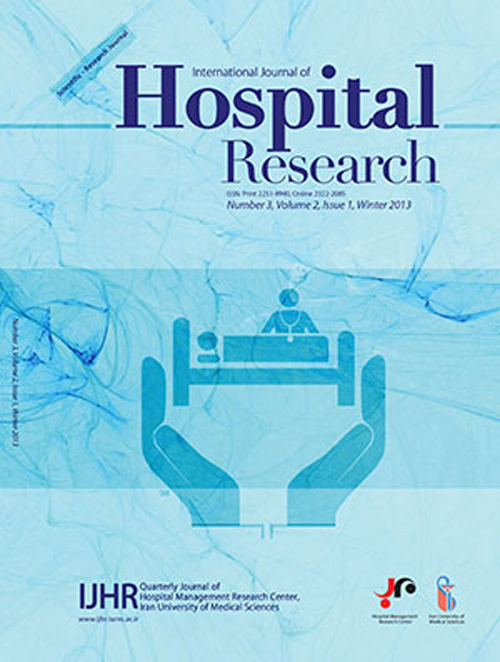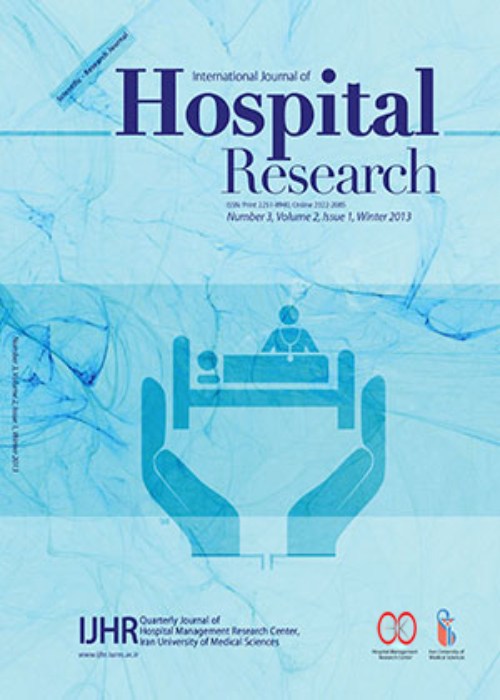فهرست مطالب

International Journal of Hospital Research
Volume:6 Issue: 1, Winter 2017
- تاریخ انتشار: 1396/05/07
- تعداد عناوین: 8
-
-
Page 1Background And ObjectivesThis paper has attempted to explore physicians and staff's views about evaluation system problems and its impact on maintaining professional behavior in clinical setting within the context of Iran.MethodsData were collected through 22 focus group sessions from October 2015 to March 2016.
Findings: All of the participants were Iranian nationals, and educate or work in one of the hospitals affiliated with the Tehran University of Medical Sciences (TUMS). Regarding evaluation challenges, 173 most expressed codes were categorized as follows: lack of appropriate evaluation, weakness in supervision, and feedback system problems.ConclusionsIn order to professionalism improvement in clinical setting, evaluation and supervision needed more attention. Appropriate supervision and evaluation systems should be defined, evaluations should be performed in safe environments, proper feedback should be provided for professional performance in individual and group levels, and finally the effect of these steps on professionalism improvement should be assessed.Keywords: Evaluation, supervision, Medical Professionalism, Clinical Environment, Qualitative research, Professional Behavior -
Page 2Background of the Study: Patient discharge process starts from the point of the initial order of the physician order and continues to the discharge time of a patient and the release of the bed that was allocated to him/her. Lengthening the patient discharge process is regarded as a negative factor in the management of beds; this lengthy process leads to delay in accepting new patients, increases the waiting time for the patients who demand an empty bed (especially in emergencies), imposes extra costs on the hospital, and creates some other problems. Therefore, discharge process pattern extraction and analysis can be helpful to shorten this process, accelerate the process of admission, reduce the costs of hospital, etc.MethodsIn the present study, first, the fuzzy model of the hospital's discharge process and the hospital's workflow pattern have been drawn according to the most frequent patterns in the data and based on the expert's opinions. Afterwards, the dotted charts of the different sectors have been extracted and analyzed using the process mining tools.
Findings: After analyzing the dotted charts, the delayed segments were specified on the pattern of the workflow and finally, some suggestions have been offered through separating the four areas of the human resources, the system, the environment.ConclusionThe discharge process of a hospital is associated with almost all its sectors and to improve it, a huge part of the organization is involved.Keywords: The Hospital Discharge Process, Workflow Pattern, Process Detection, Process improvement -
Page 3Background And ObjectivesMalnutrition is highly prevalent worldwide among hemodialysis patients and is one of the strongest predictors of morbidity and mortality.This study was conducted to estimate the prevalence of malnutrition and to determine the related demographic socioeconomic factors associated with malnutrition indicators among hemodialysis patients at Al-Shifa Medical Complex in Gaza Strip, Palestine.MethodsThis cross sectional study was conducted among sixty hemodialysis patients (both gender, aged 19-59 years on regular hemodialysis for at least six months) receiving care at Al-Shifa Medical Complex in Gaza Strip, Palestine. Patients were assessed using; anthropometric indices, physical examination, biochemical tests and a structured questionnaire. Statistical analysis was performed using SPSS version 20.
Findings: Approximately two thirds of hemodialysis patients showed biochemical malnutrition indicators. These includes: hypoalbuminemia 66.7%, low predialysis serum creatinine 65%, low serum cholesterol 61.7% and low Body Mass Index (BMI), where, 45.0% of the patients had BMI less than the recommended BMI (23.8 kg/m²) for hemodialysis patients. Malnourished patients and those with lower serum albumin had significantly higher rate of emergency department visits and number of admission days to the hospitals over a year (PConclusionsOur results clearly showed that malnutrition is highly prevalent among hemodialysis patients and closely related to morbidity and mortality. Furthermore, sociodemographic and economic factors contribute to this higher percentage of malnutrition.Keywords: Chronic Kidney Disease, Hemodialysis, malnutrition, Palestine -
Page 4Background And ObjectivesAnal fissure is a painful wound in the anoderm and distal to dentate line, the chronic fissure leads to hypertrophy and fibrosis. In this study, we compared partial and total sphincterotomy in patients with chronic anal fissure.MethodsIn this comparative cohort, 100 patients (52 female and 48 male )mean age 43.34 ± 15.28 years with chronic anal fissure referred to the Shahid Mohammadi Hospital, Bandar Abbas, Iran were randomly assigned into partial or total sphincterotomy groups (50 patients in each group). Then the postoperative complications including, pain, bleeding, incontinence to flatus or to flatus and soiling, infection and abscess, hematoma, anal stenosis and recurrence of anal fissure within one year after operation were compared between two groups.
Findings: The flatus incontinence in total group was significantly more than partial, and the level of pain in total group was significantly lower than partial. The rate of recurrence and incontinence to flatus and soil in total group was non- significantly more than the partial group. On the other hand, Bleeding and hematoma, infection, abscess and discharge in total group was lower than partial, but the difference was not significant. Satisfaction in two groups was the same.Conclusionswe revealed the effectiveness of partial and total sphincterotomy techniques in patients with chronic anal fissure and showed two approaches were associated with comparable outcomes. However, total sphincterotomy was related to lower pain and partial sphincterotomy with lower flatus incontinence.Keywords: Anal fissure, partial sphincterotomy, total sphincterotomy, flatus, soil incontinence, Pain -
Page 5Background And ObjectivesHospitals severely influence system of sanitary cares. The effect of coping styles and social support on the results of medical remedies maybe leads to methods for reduction in the costs of medical cares. The goal of present study was comparison of coping styles and social support among patients of private and state hospitals of Kerman city.Methods101 bedridden patients in private hospitals and 101 bedridden patients in state hospitals of Kerman randomly were selected. Scales of Coping Styles (Moss & Billings) and Social Support (Stewart & Sherbourn) were used. In order to analyze the data, methods of descriptive statistics and multivariable analysis of variance (MANOVA) were applied.
Findings: Patients of state hospitals use coping style of emotion-focused more than patients of private hospitals. Also,the evaluation of patients of informational support in private hospitals was more than state hospitals.ConclusionAs for the results of this study, teaching the appropriate coping styles, informing the families and personnel of hospitals about the importance of social support and codification and improvement in the policies for promotion of the hospital services is necessary.Keywords: coping styles, Social Support, Private Hospital, state hospital -
Page 6Background And Objectivesit is well established that pulmonary thromboembolism is frequent in patients with trauma, in this study we compared pulmonary thromboembolism before and after the autopsy in patients with traumaMethodsIn this cross-sectional study, the patients being referred to three of teaching hospitals of Tehran from March 2015 to March 2016 because of trauma and died in hospital due to the diagnosis of pulmonary embolism were recruited. Then the patients were autopsied and the cause of death was evaluated and the frequency of PE was compared before and after the autopsy.
Findings:168 patients with PE (108 males 64.3%and 60females35.7%) mean age 48.5 years were evaluated. after the autopsy, PE was diagnosed in 50% of the patients. The correlation between age and autopsy was significant (r=0.47, P=0.006), however, the correlation between sex, underlying disease, and the hospitalization duration was not significant.Conclusionswe indicated that among patients with trauma, 50% of premortem diagnosis of PE did not confirm by autopsy, additionally we indicated that age was significantly correlated to the PE.Keywords: pulmonary thromboembolism, autopsy, Trauma -
Page 7Background And ObjectivesThe necessity of assessing safety in hospitals lies with the fact that although accidents are rare, they impose considerable financial loads on hospital. Along with examining the risks, the managers of hospitals need to improve their capabilities and standards and reduce the hazards caused by accidents. The present study is aimed at assessing functional, structural, and non-structural safety in Farabi Eye Hospital between 2014 and 2016.MethodsThe study was carried out as an applied work using qualitative methods. Study population was comprised of different wards of the hospital and the data was collected by observing the wards in hospital field. The data was collected using Hospital Disaster Risk Assessment (WHO). This checklist studies 145 hospital safety indices in three scopes of performance, structural and nonstructural safety. Excel was used to analyze the collected data.
Findings: As the findings indicated Functional safety level (91.83%), Non-structural safety level (31.03%), Structural safety level (58.69%)and totally47.59% safety condition had followed a steady increasing trend over the three years period.Conclusionsunder study; still improvements are needed in each field. In addition, safety level must be examined frequently on yearly basis to achieve the world standards.Keywords: Assessment, Structural safety, Non-structural safety, Hospital, Farabi, Iran -
Page 8Background And ObjectivesFire is an inherent and permanent risk in the operating room and the prevention of it in the operating room require awareness of risks and effective communication between its staffs. Thus the purpose of this study is to determine the awareness and the practice of the operating room staff about fire prevention and to determine the effectiveness of safety training on the awareness and the practice of fire prevention in operating room staff.MethodsThis study is a quasi-experimental intervention that has been done on 64 staff in the operating room in 5 hospitals in Khuzestan province. Sampling was done randomly for two groups the case and the control. After matching the samples based on age, work experience and previous training, the case group indirectly trained in the field of fire, and compare for evaluating the effectiveness of training by the control group. The instrument of this study includes the fire questionnaire, the demographic questionnaire and educational poster. The collected data were analysed by paired t-test and t-test of SPSS16.
Findings: The results showed that the mean of the awareness and performance value in the case group before the intervention are respectively 2.6 and 3.93 and after the intervention are 3.1 and 3.9. This difference was statistically significant for awareness (P0.05). There is no significant difference between the case and control groups in knowledge value before the intervention (P>0/05) but after the intervention, shows a significant difference between these groups (P0/05).Conclusionsthe results show that safety training is useful for operating room staff and have a positive effect on increasing knowledge and practice of operating room personnel.Keywords: safety training, Awareness, practice, fire prevention, operating room personnel


